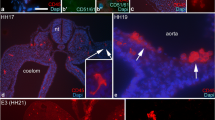Abstract
Ellipsoids, the extra-vasculature sites surrounding penicilliary capillaries of the chicken spleen, play critical roles in the immune response and also in the clearance of pathogens or other particles. The meshwork of ellipsoids is formed by fibroblastic reticular cells. To characterize ellipsoidal reticular cells, a series of monoclonal antibodies against the chicken spleen have been developed. Of these antibodies, CSA-1 antibody reacts with fibroblastic reticular cells in ellipsoids and with endothelial cells. The reticular nature of positive cells in ellipsoids is indicated by immuno-electron microscopy, and by double-staining with anti-heat-shock protein 47 kDa (hsp47) antibody. The reaction of CSA-1 with reticular cells is limited in ellipsoids; CSA-1 does not react with reticular cells in other lymphoid organs. These findings indicate that ellipsoidal reticular cells share the antigen with endothelial cells. Ontogenic studies reveal that, on embryonic day 18, the development of ellipsoids is completed, penicilliary capillaries become fenestrated, and CSA-1 expression in ellipsoids begins. These findings suggest that CSA-1 is expressed on the cell surface of ellipsoidal reticular cells once they are exposed to blood flow.
Similar content being viewed by others
References
Berg TKVD, Döpp EA, Breve JJP, Kraal G, Dijkstra CD (1989) The heterogeneity of the reticulum of rat peripheral lymphoid organs identified by monoclonal antibodies. Eur J Immunol 19:1747–1756
Blue J, Weiss L (1981a) Electron microscopy of the red pulp of the dog spleen including vascular arrangements, periarterial macrophage sheath (ellipsoids), and the contractile, innervated reticular meshwork. Am J Anat 161:189–218
Blue J, Weiss L (1981b) Periarterial macrophage sheaths, (ellipsoids) in cat spleen — an electron microscope study. Am J Anat 161:115–134
Fukuta K, Nishida T, Mochizuki K (1976) Electron microscopy of the splenic circulation in the chicken. Jpn J Vet Sci 38:241–254
Giorno R (1984) Unusual structure of human splenic sinusoids revealed by monoclonal antibodies. Histochemistry 81:505–507
Hamburger V, Hamilton HL (1951) A series of normal stages in the development of the chicken embryo. J Morphol 88:49–92
Irino S, Murakami T, Fujita T (1977) Open circulation in the human spleen. Dissection scanning electron microscopy of conductive-stained tissue and observation of resin vascular casts. Arch Histol Jpn 40:297–304
Jeurissen SHM, Janse EM, Koch G, Boer GFD (1988) The monoclonal antibody CVI-CHNL-68.1 recognizes cells of the monocyte-macrophage lineage in chickens. Dev Comp Immunol 12:855–864
Jeurissen SHM, Janse EM, Kok GL, Boer GFD (1989) Distribution and function of non-lymphoid cells positive for monoclonal antibody CVI-ChNL-68.2 in healthy chickens and those infected with Marek's disease virus. Vet Immunol Immunopathol 22:123–133
Kaneshima H, Ito M, Asai J, Taguchi O, Hiai H (1987) Thymic epithelial reticular cell subpopulations in mice defined by monoclonal antibodies. Lab Invest 56:372–380
Kishimoto T, Taga T, Akira S (1994) Cytokine signal transduction. Cell 76:253–262
Köhler G, Milstein C (1975) Continuous cultures of fused cells secreting antibody of predefined specificity. Nature 256:495–497
Kurkinen M, Taylor A, Garrels JI, Hogan BLM (1984) Cell surface-associated proteins which bind native type IV collagen or gelatin. J Biol Chem 259:5915–5922
Miyaishi O, Sakata K, Matsuyama M, Saga S (1992) Distribution of the collagen binding heat-shock protein in chicken tissues. J Histochem Cytochem 40:1021–1029
Nagata K, Yamada KM (1986) Phosphorylation and transformation sensitivity of a major collagen-binding protein of fibroblasts. J Biol Chem 261:7531–7536
Nagata K, Saga S, Yamada KM (1986) A major collagen-binding protein of chick embryo fibroblasts is a novel heat shock protein. J Cell Biol 103:223–229
Nanba K, Itagaki T, Ono T, Hara H, Iijima S (1979) Comparative morphology of the perifollicular region of spleens of birds and mammals. Recent Adv Res 19:15–42
Ohbayashi M, Ito M, Nakayama A, Kasai K, Asai J (1993) Immunohistochemical and functional studies on rat high endothelial venules using monoclonal antibodies. Virchows Archiv [B] 63:297–306
Oláh I, Glick B (1982) Splenic white pulp and associated vascular channels in chicken spleen. Am J Anat 165:445–480
Oláh I, Glick B, Taylor RL (1984) Effect of soluble antigen on the ellipsoid-associated cells of the chicken's spleen. J Leukocyte Biol 35:501–510
Saga S, Nagata N, Chen WT, Yamada KM (1987) pH-dependent function, purification, and intercellular location of a major collagen-binding glycoprotein. J Cell Biol 105:517–527
Seto M, Takahashi T, Tanimoto M, Nishizuka Y (1982) Production of monoclonal antibodies against MM antigen: the serologic of MM antigen with Ly-6.2 alloantigen. J Immunol 128:201–205
Springer TA (1994) Traffic signals for lymphocyte recirculation and leukocyte emigration: the multistep paradigm. Cell 76:301–314
Taylor A, Hogan BLM, Watt FM (1985) Biosynthesis of EGF receptor, transferrin receptor and collagen by cultured human keratinocytes and the effect of retinoic acid. Exp Cell Res 159:47–54
Weiss L (1990a) The spleen in malaria: the role of barrier cells. Immunol Lett 25:165–172
Weiss L (1990b) Mechanisms of splenic clearance of the blood: a structural overview of the mammalian spleen. In: Bowdler AJ (ed) The spleen. Chapman and Hall, London, pp 23–43
White RG, French VI, Stark JM (1970) A study of the localization of a protein antigen in the chicken spleen and its relation to the formation of germinal centres. J Med Microbiol 365–76
Wolf BC, Neiman RS (1989) Disorders of the spleen. Saunders, Philadelphia
Author information
Authors and Affiliations
Rights and permissions
About this article
Cite this article
Kasai, K., Nakayama, A., Ohbayashi, M. et al. Immunohistochemical characteristics of chicken spleen ellipsoids using newly established monoclonal antibodies. Cell Tissue Res 281, 135–141 (1995). https://doi.org/10.1007/BF00307967
Received:
Accepted:
Issue Date:
DOI: https://doi.org/10.1007/BF00307967




